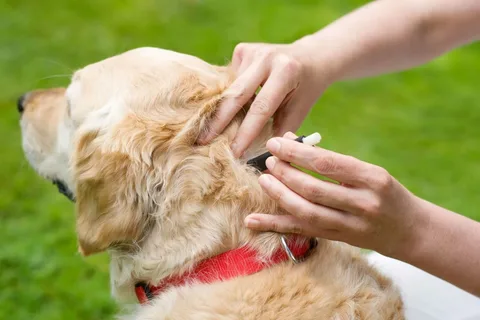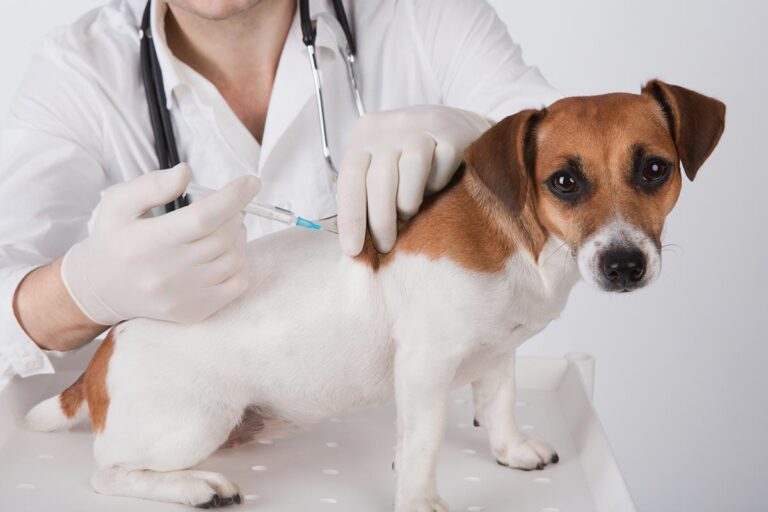Recognizing and Treating Fleas and Ticks – A Guide to Pet’s Health

Protecting Your Pup from Pesky Parasites
Our beloved canine companions deserve a life free from discomfort and irritation. Unfortunately, pesky parasites like fleas and ticks can wreak havoc on their well-being. This comprehensive guide equips you with the knowledge to recognize, treat, and prevent these unwelcome guests, ensuring your dog stays happy and healthy.
The Menace of Fleas: Tiny Biting Bandits
Fleas are wingless insects that feed on the blood of animals, including dogs. These tiny terrors can cause a multitude of problems for your furry friend:
- Intense Itching: Fleas have a painful bite, leading to excessive scratching, licking, and chewing. This can cause hair loss, hot spots, and even secondary skin infections.
- Tapeworms: If your dog ingests an infected flea while grooming, they can contract tapeworms, causing digestive issues.
- Allergic Dermatitis: Some dogs develop allergies to flea saliva, resulting in severe itching, inflammation, and skin irritation.
Signs of Fleas on Dogs:
- Excessive Scratching: This is the most common sign.
- Visible Fleas: Part your dog’s fur and look for small, reddish-brown insects hopping around.
- Flea Dirt (Flea Frass): These black specks – flea droppings – often appear on your dog’s fur, bedding, or carpeting.
- Hair Loss: Constant scratching and irritation can lead to patchy hair loss, especially around the tail base, back, and legs.
- Red, Inflamed Skin: Fleas bites can cause inflamed, red patches on your dog’s skin.
Tick Talk: Tiny Terrors with Big Risks
Ticks are blood-sucking arachnids that attach themselves to your dog’s skin and feed. While less common than fleas, they pose a more serious threat due to the diseases they can transmit:
- Lyme Disease: This bacterial infection can cause fever, lethargy, joint pain, and kidney problems.
- Rocky Mountain Spotted Fever: This serious illness can cause a high fever, rash, and muscle aches.
- Anaplasmosis: This tick-borne disease affects the immune system and can lead to lethargy, fever, and loss of appetite.
Signs of Ticks on Dogs:
- Visible Ticks: Carefully examine your dog’s fur, especially around the ears, head, neck, and legs. Ticks appear as small bumps that grow larger as they feed.
- Redness and Irritation: The area around a tick bite might be red, swollen, and irritated.
- Listlessness and Lethargy: If your dog has contracted a tick-borne illness, they might exhibit signs of fatigue and weakness.
Combating the Critters: Effective Flea and Tick Treatment
If you suspect your dog has fleas or ticks, immediate action is crucial. Here’s what to do:
- Remove Fleas or Ticks: Carefully remove any visible fleas or ticks with a flea comb or tick removal tool. Be sure to dispose of them properly.
- Veterinary Visit: Schedule a vet appointment for a definitive diagnosis and treatment plan. Depending on the severity of the infestation, your veterinarian might recommend oral medications, topical treatments, or environmental flea control products.
Plush Puppy Grooming Products : While consulting your vet is crucial, consider using gentle grooming products alongside professional treatment. Plush Puppy offers a variety of dog shampoos that can help soothe irritated skin caused by fleas and ticks:
- Plush Puppy Oatmeal Shampoo: The calming properties of oatmeal can help alleviate itching and discomfort associated with flea bites.
- Plush Puppy Aloe Vera Shampoo: Aloe vera has soothing and anti-inflammatory properties that can help reduce skin irritation.
Please note: These shampoos are not a replacement for veterinary treatment but can offer additional comfort during the treatment process.
Prevention is Key: Keeping Fleas and Ticks at Bay
The best way to deal with fleas and ticks is to prevent them in the first place. Here are some effective prevention strategies:
- Regular Veterinary Checkups: Schedule regular checkups with your veterinarian, who can recommend appropriate flea and tick prevention medications.
- Year-Round Prevention: Don’t be fooled by the seasons. Fleas and ticks can be active year-round, so maintain consistent prevention throughout the year.
- Environmental Control: Vacuum your home regularly, wash your dog’s bedding in hot water, and treat your yard with a pet-safe flea and tick control product.
- Maintain a Healthy Coat: Regular brushing helps remove fleas and ticks and keeps your dog’s coat healthy,
Conclusion:
A Proactive Approach for a Pest-Free Pup
Fleas and ticks can be a nuisance for both you and your dog. By understanding the signs, treatment options, and preventative measures outlined in this guide, you can become a pro at protecting your furry friend from these pesky parasites. Remember, early detection and prompt action are key. If you notice any signs of fleas or ticks, don’t hesitate to schedule a visit with your veterinarian.
Living with a happy and healthy dog starts with proactive care. Implement a regular flea and tick prevention plan recommended by your veterinarian, maintain a clean environment, and keep your dog’s coat healthy with regular brushing. Consider incorporating gentle grooming products like Plush Puppy Oatmeal Shampoo or Plush Puppy Aloe Vera Shampoo to soothe any irritation caused by these parasites (Remember, consult your vet first for diagnosis and treatment).
With a little vigilance and the right approach, you can ensure your dog stays free from fleas and ticks, allowing them to enjoy life to the fullest.
FAQs: Addressing Flea and Tick Concerns
Here are some frequently asked questions (FAQs) to shed light on common concerns related to fleas and ticks on dogs:
- How can I tell if my dog has fleas?
The most common signs include excessive scratching, visible fleas or flea dirt (black specks) on their fur, hair loss, and red, inflamed skin.
- What should I do if I find a tick on my dog?
Carefully remove it with a tick removal tool and dispose of it properly. Schedule a vet visit to ensure complete removal and check for potential diseases.
- What is the best flea and tick prevention for dogs?
Your veterinarian can recommend the most suitable product based on your dog’s age, breed, and lifestyle.
- Are there any home remedies for fleas and ticks?
While some home remedies like neem oil or apple cider vinegar baths might offer temporary relief, consulting a vet for professional treatment and prevention is crucial.
- Can I use human flea and tick medication on my dog?
Never use human medications on your dog. They can be toxic and cause serious health problems.
- How often should I bathe my dog to prevent fleas and ticks?
Frequent baths alone won’t prevent fleas and ticks. However, regular bathing with a gentle dog shampoo like Plush Puppy Oatmeal Shampoo can help soothe irritated skin caused by these parasites. Always consult your vet about your dog’s specific bathing needs.
- My dog is on flea and tick prevention, but I still see fleas. What should I do?
If you see fleas even with prevention, consult your veterinarian. They might need to adjust the medication or recommend additional environmental control measures.
By staying informed and taking proactive steps, you can ensure your dog enjoys a happy, healthy life free from the discomfort and dangers posed by fleas and ticks.
What do you think?
Related Articles

Pups & Protection: A Complete Guide to Dog Vaccinations in India
Vaccinating your dog is a vital part of responsible pet ownership. It protects them from potentially life-threatening diseases and helps

Canine Cuisine: Decoding What’s Safe and Nutritious for Your Dog
Our canine companions look at us with those hopeful eyes, and sometimes it’s tempting to share our meals with them.

A Tail-Waggingly Good Time: Exploring Various Dog Toys
For our furry companions, playtime isn’t just fun – it’s essential! Dog toys provide physical and mental stimulation, keep boredom
